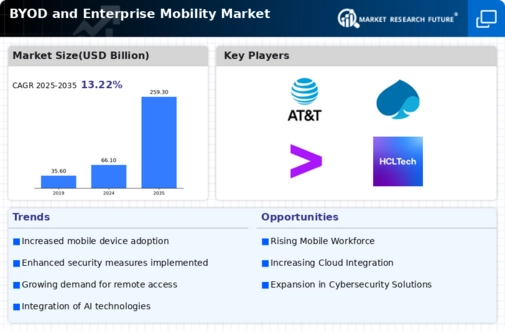Market Analysis
In-depth Analysis of BYOD Enterprise Mobility Market Industry Landscape
The Bring Your Own Device (BYOD) and enterprise mobility market has been experiencing rapid growth and evolution in recent years, driven by the increasing adoption of mobile devices and the growing demand for flexible work environments. BYOD refers to the practice of allowing employees to use their personal devices, such as smartphones, tablets, and laptops, for work-related tasks, while enterprise mobility encompasses the strategies, technologies, and policies used to manage and secure mobile devices, applications, and data within organizations. One of the key trends in this market is the widespread adoption of BYOD policies by businesses of all sizes and across various industries. BYOD enables employees to work from anywhere, at any time, using their preferred devices, which can improve productivity, flexibility, and job satisfaction. Additionally, BYOD can result in cost savings for organizations by reducing the need to purchase and manage corporate-owned devices.
Moreover, there is a growing emphasis on security and compliance within the BYOD and enterprise mobility market. As employees access corporate data and applications from their personal devices, there is a heightened risk of data breaches, unauthorized access, and compliance violations. To address these concerns, organizations are implementing mobile device management (MDM), mobile application management (MAM), and mobile security solutions to secure, monitor, and control employee-owned devices and applications. These solutions enable organizations to enforce security policies, encrypt data, and remotely wipe or lock devices in case of loss or theft, thereby mitigating risks and ensuring compliance with regulatory requirements.
Another key trend in the BYOD and enterprise mobility market is the integration of unified endpoint management (UEM) solutions to manage and secure a diverse range of endpoints, including mobile devices, desktops, laptops, and IoT devices, from a single platform. UEM solutions provide centralized visibility and control over all endpoints, enabling organizations to streamline device provisioning, configuration, and security management processes. By adopting UEM solutions, organizations can simplify IT operations, improve efficiency, and enhance security posture across their entire device fleet, regardless of device type or operating system.
Furthermore, there is a growing demand for mobile productivity and collaboration tools to support remote work and enable seamless communication and collaboration among distributed teams. With the increasing adoption of cloud-based productivity suites such as Microsoft 365 and Google Workspace, employees can access email, documents, calendars, and collaboration tools from any device, anywhere, with an internet connection. Additionally, organizations are leveraging enterprise mobility solutions such as mobile email clients, file sharing applications, and unified communication platforms to enable real-time communication, document sharing, and project collaboration on the go. These mobile productivity tools empower employees to stay connected, productive, and collaborative, whether they are in the office, at home, or on the road.
Moreover, there is a growing trend towards the adoption of mobile-first and cloud-native applications to support digital transformation initiatives and enable innovative business processes. Organizations are developing and deploying mobile applications that are optimized for mobile devices and leverage cloud infrastructure and services to deliver scalable, flexible, and cost-effective solutions. Mobile-first applications enable employees to access critical business systems and data from their smartphones or tablets, enabling greater agility, responsiveness, and efficiency in day-to-day operations. Additionally, organizations are embracing low-code and no-code development platforms to accelerate the development and deployment of mobile applications, enabling business users to create and customize applications without requiring extensive coding skills.
Additionally, the BYOD and enterprise mobility market is witnessing increased adoption in industries such as healthcare, retail, and manufacturing, where mobility is essential for frontline workers to perform their jobs effectively. Mobile devices and applications enable healthcare providers to access electronic health records (EHRs), communicate with colleagues, and coordinate patient care from anywhere within the hospital or clinic. In the retail sector, mobile devices empower store associates to check inventory, process transactions, and provide personalized customer service on the shop floor. Similarly, in manufacturing environments, mobile devices and applications enable workers to access work instructions, report issues, and track production processes in real time, improving productivity and efficiency on the factory floor.







Leave a Comment